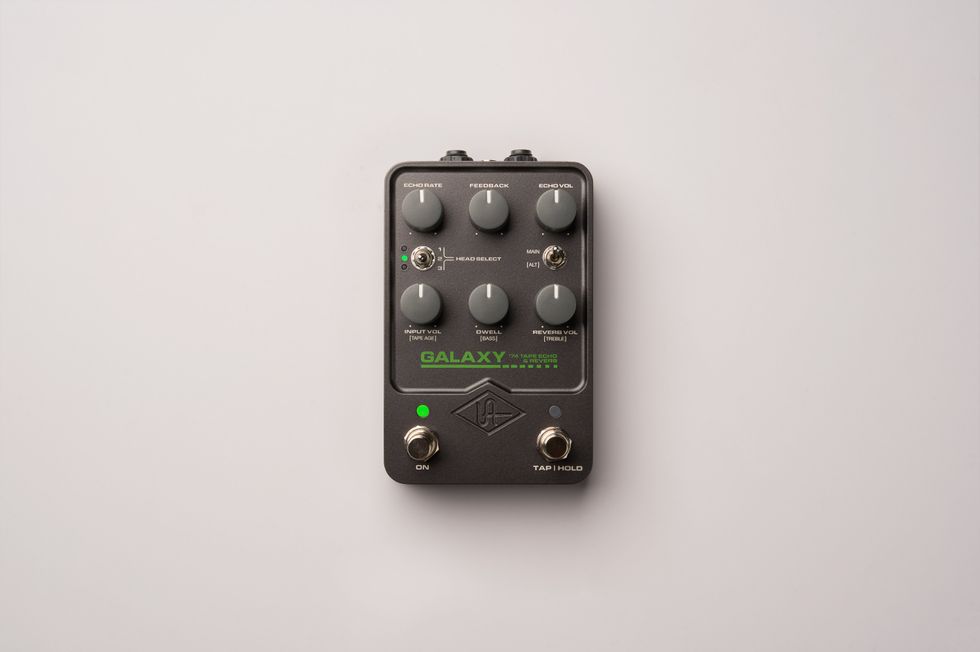
A Space Echo-inspired delay and reverb that offers many of the real thing’s tactile joys—on top of the positively dreamy sounds.
Every effect is, to some extent, its own instrument. But few effects are instruments in the way that the Roland RE-201 Space Echo is a playable, almost living thing. In its original incarnation, the RE-201’s dimensions and layout had much to do with how artists interacted with it. Unlike a stompbox, it was built to sit atop an amp, keyboard, mixing desk, or in a studio rack. And by virtue of that orientation—more aligned with the hands than the feet—and it’s well-spaced, generously sized controls, it compelled users to manipulate its echoes while playing or mixing.
It’s tough to stuff those design attributes of the RE-201 into a stompbox. But Universal Audio’s Galaxy ’74 has much of the touch—if not quite all the ergonomic advantages—that made the RE-201 so compelling to tinker with. And its sounds are deep, rich, and very suggestive of, if not indiscernible from, its analog tape echo inspiration.
“The knobs have a lovely resistance that enables you to turn them simultaneously and easily with one hand, all with a great sense of precision.”
Plug In to Freak Out
The Galaxy ’74 pedal uses the same algorithm that drives Universal Audio’s superb Galaxy Space RE-201-style plugin, though the spring model is new in the pedal. (The Galaxy plugin is my go-to echo, and often my reverb of choice when working in UA’s Apollo environment). Running that algorithm requires an enclosure big enough to accommodate a powerful chip, keep it cool, and run at 9 volts. There is an upside to the larger size though. The bigger enclosure makes the Galaxy ’74 a joy to operate in a hands-on fashion just as you might manipulate a real Space Echo. The controls are comfortably spaced. The knobs have a lovely resistance that enables you to turn them simultaneously and easily with one hand, all with a great sense of precision. There’s also room for two multi-function footswitches, one of which can be held down to simulate the self-oscillating feedback effects that are a Space Echo specialty.
The controls themselves approximate the most vital RE-201 controls. They include echo rate, feedback, echo volume (mix), input volume, reverb dwell, and reverb mix. The bass and treble controls are accessed using the conveniently placed “alt” toggle, which also converts the input volume knob to a tape-age control, which adds virtual wow, flutter, and oxidation. The 12-position rotary switch that selects combinations of the three tape heads on a RE-201 is replaced here by a toggle that clicks through those permutations. The “reverb only” setting can be achieved by reducing the echo volume knob to zero.
Deep Space and Grease Pits
Take this with a grain of salt because I’ve been on a minimalist streak. But it occurred to me while testing the Galaxy that you could quite assuredly go into a session or gig with this pedal alone and create whole worlds of sound. Take the input volume control: While you won’t be able to achieve the same range of drive you’d get from a dedicated overdrive pedal, the input volume adds cool, dirty tape saturation colors that are a smoky, hazy alternative to the same old pedal or amp overdrive. It also lends attitude to greasy slapback tones and a little extra blur and glue to subtle doubling effects—all of which serve as a reminder that the Galaxy is useful for much more than lunatic space-bending effects.
Ah, but how glorious those lunatic space-bending effects are here. The echoes are resonant with beautiful overtones that bloom beautifully at the verge of feedback or situated in the background, subtly adding space and breath to a melodic chord phrase. The sensitivity in the Galaxy’s controls makes these overtones and the interactions between feedback, mix, input volume, and the reverb a thrill to manipulate. There are nearly infinite shades of echo coloration to explore. And the ergonomic way the knobs are laid out—just about everything can be manipulated simultaneously with the fingers of one hand—makes the process of shaping echo, reverb, and drive interactions feel almost painterly. Guitarists that dabble in the world of synths and keyboards are likely to treasure this facet of Galaxy’s functionality too.
As you’d expect from UA, a fixation with authenticity led to replication of RE-201’s quirkiest quirks. Among the coolest of these is the way the Galaxy ramps up or down and changes pitch as you change delay time. On the RE-201, the mechanical lag in this process lends the ramping effect a very unique, ghostly eeriness. (Producer Nigel Godrich is a master at utilizing this effect.) It’s a big part of a RE-201’s personality, and that idiosyncrasy is retained here and can be used to intoxicating ends.
The Verdict
The features described here detail the Galaxy ’74’s core features. But additional functionality, activating delay trails for instance, can be unlocked via the UAFX Control app. And the beauty of the Galaxy ’74 is that everything you need to achieve real Space Echo-grade liftoff is here in an intuitive, easy-to-manage, and easy-to-manipulate package that sounds spectacular.
Universal Audio Galaxy ’74 Tape Echo | First Look
From Your Site Articles
Related Articles Around the Web









